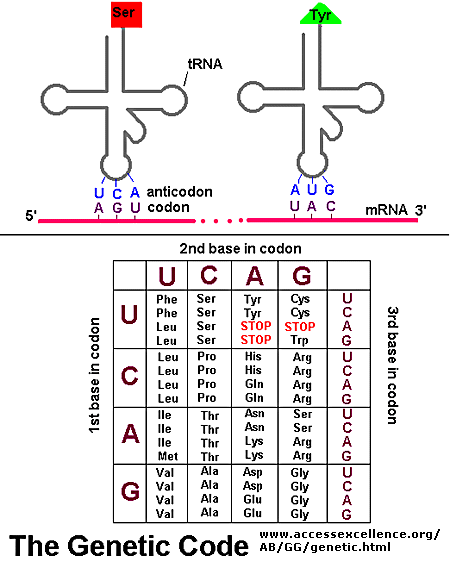Daily Newsletter March 28, 2012
Today's Topic:
Codons and Anticodons Translation is the process of "reading" mRNA, and using the code to construct a protein. But what is the code? The nucleotide language of mRNA can be divided into codons. Three sequential nucleotides that represent a genetic (nucleotide) word.
In the image below, you have have sequential nucleotides divided up into codons. Notice that AUG is listed as Codon 1. This is important! AUG is the Universal Start Codon. Nearly every organism (and every gene) that has been studied uses the three ribonucleotide sequence AUG to indicate the "START" of protein synthesis (Start Point of Translation).
As we will see tomorrow, it takes more than a start codon to initiate transcription. The start codon sets the start point.
The start codon established the Reading Frame for translation. From the start codon, every three sequential nucleotides will be viewed as a codon. This is critical! Mutations can affect reading frames. For example, if a nucleotide as inserted between codon 2 and 3 (G G), would you have the same reading frame down stream? What is you deleted the first nucleotide of codon 4? What is the effect of changing the reading frame? What would happen to the resulting protein?
Insertions and deletions can change reading frames, but point mutations can also occur. In this case, one nucleotide is change to a different nucleotide. What would happen if the final nucleotide of condon 3 were changed to a C? To an A? How about the second nucleotide in codon 4? Change the U to an A, what happens?
Each codon is a "genetic word", and can be translated into a specific protein. The tRNA is the agent of translation. On one end of the tRNA, you will find an anti-codon. Anti-codons are complimentary to codons. Example: Codon 1 reads AUG. The corresponding tRNA would have an anticodon reading UAC. (Question: Would these be antiparallel?). Codon 2 reads ACG, so the anticodon would read UGC.
An amino acid can be attached to the free 3' end of the tRNA. There is a class of enzymes capable of attaching an amino acid to a tRNA: Aminoacyl tRNA Synthetase. Below is a very basic cartoon of how an amino acid is added to a tRNA.
Below is a diagram showing the pairing of codon to anticodon. The diagram also contains a version of the Genetic Code table, showing the relationship between codon and amino acid.
Note that three codons are referred to as STOP codons: UAA, UAG, and UGA. These are used to terminate translation; they indicate the end of the gene's coding region. What would happen if you lost a Stop codon?
Daily Challenge:Genetic Code
In your own words, describe the genetic code and how codons/anticodons work to relate the genetic code to amino acids. Discuss what can happen if the coding sequence is change by either changing, adding or deleting a nucleotide.



No comments:
Post a Comment